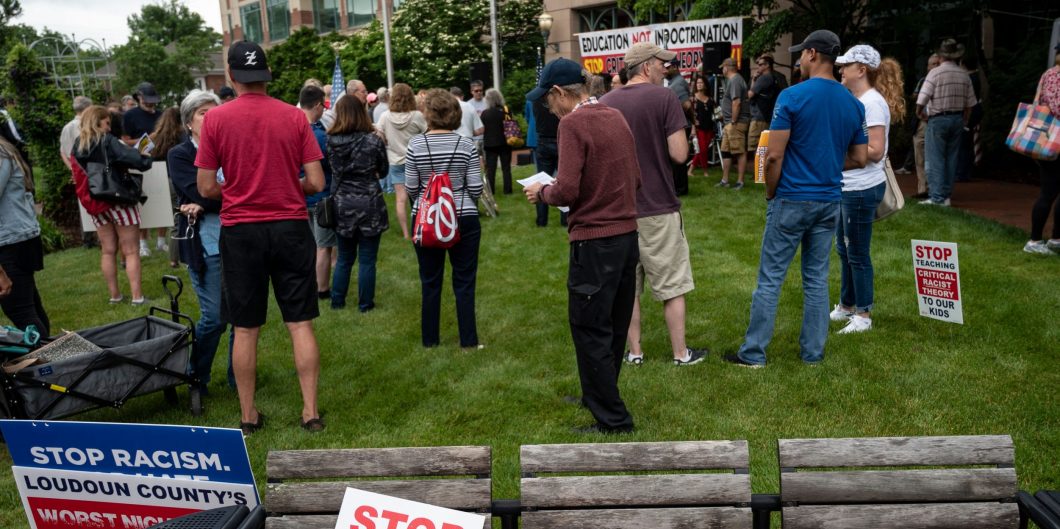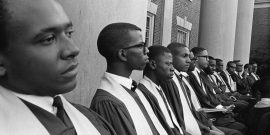King approached racial justice very differently from modern-day activists, stressing the dignity of all human beings.
How the Grassroots Are Resisting CRT
The popular revolt against Critical Race Theory has shocked the woke establishment. We can see in its schizophrenic and unsteady reaction just how spooked it is. Consider, for example, how teachers’ unions have gone from denying that CRT is used in classrooms, to vowing in their next breath to promote it among the country’s 14,000 school districts, and threatening to do “oppo research” or sue anyone who opposes CRT.
You can’t have it both ways, guys.
Another tactic is to smear this all-American, parent-led movement as astroturf, but to do so indirectly, in an underhanded way that slurs their actions while claiming plausible deniability. The subterfuge here is to pretend that it is institutions such as the one I work for, The Heritage Foundation, that are instigating the swelling wave of opposition to CRT. As someone who has spoken to hundreds of parents across the country (and plan to do so again and again throughout the summer) and who has also spoken to state legislators across the nation, including testifying before the Louisiana Legislature along with my Heritage colleague Jonathan Butcher, I can tell you that the energy is coming from the grassroots, and it is very real.
Those making this claim know this all too well, which is the reason they are panicking. Strategically, however, it is better to blame a behemoth like Heritage than the parents of the children your union members allegedly serve. Thus, at its most recent Representative Assembly (June 30-July 3), the country’s largest teachers union, the National Education Association, approved Business Item No. 2, which warned that “The attacks on anti-racist teachers are increasing, coordinated by well-funded organizations such as the Heritage Foundation. We need to be better prepared to respond to these attacks so that our members can continue this important work.”
The NEA also passed Business Item No. 39, which promised to “Share and publicize, through existing channels, information already available on critical race theory (CRT)—what it is and what it is not; have a team of staffers for members who want to learn more and fight back against anti-CRT rhetoric.” It adds: “it is reasonable and appropriate for curriculum to be informed by academic frameworks for understanding and interpreting the impact of the past on current society, including critical race theory.”
The measures are new business items approved at the annual conference. The NEA for example approved spending $56,500 to attack anti-CRT groups, naming Heritage, and $127,600 to support Business Item 39.
But when conservative or libertarian outlets, such as Reason Magazine, pointed out how maladroit the NEA had been in admitting that CRT was indeed being used in the classroom, the NEA did what all Stalinists always do: it airbrushed the past. The union scrubbed its website of its mentions of Heritage and CRT, or the promises to use part of its multi-million dollar budget to defend the continued use of CRT. This is why the hyperlinks provided above in this essay come courtesy of the “Way Back Machine.”
Nor was it only the NEA that flipped, then flopped. The president of the American Federation of Teachers (AFT), Randi Weingarten, emphatically said that CRT was not being used at K-12 schools. But then the AFT Twitter account announced that one of AFT’s top officials was about to go on Good Morning America to talk “about how teaching critical race theory allows educators to ‘give our students the opportunity to understand the full breadth and depth of the American society.’”
But there’s more. The charge of astroturfing is not just false, but also an example of what we call “projecting” in our over-psychologized age. There is strong indication that the woke elite institutions—not just the teachers’ unions, but also the media, the academy, the federal government, etc.—are starting to use messaging packaged for them by progressive activists.
One example is the eerie similarity between the talking points that unions, MSNBC hosts, and other actors use in their current offensive against parents, and a “Messaging Guide” distributed in mid-June by a large coalition of 300 organizations and 20 foundations and other entities, the Partnership for the Future of Learning. The Partnership notably includes among its members the NEA.
Here are the top messaging points the coalition, Future of Learning, recommended:
- “Truth in our classrooms propels young people towards a more united, inclusive, and just future.
- “Trust students to talk about what’s happening in the world around them.
- “Coordinated efforts to control curriculum come from aggressive right-wing instigators who want to stop educators and districts from working toward racial equity.
- “When educators teach the truth, students start to see themselves as part of a bigger story.
- “Banning conversations about racism in schools is a form of censorship. A shared, honest understanding of the past bridges divides.”
It also recommended these more specific talking points. All those who adopt need do is add their state inside the brackets:
- “There is a long and painful history of race and education in [our state]. Students are ready for systems and institutions to change. Creating a just and equitable learning environment that embraces the history and experiences of its learners is not only good for students, but also for our communities and our shared future.
- “We cannot pretend to be race-neutral or ‘colorblind’ if we are ever going to address and account for the inequalities that students of color face.
- “Many districts around the country have already incorporated culturally responsive curricula in classrooms. The result is that students of color are affirmed and validated by having their unique histories and experiences elevated among their teachers and peers.
- “Research shows that students who see positive representations of themselves in their curriculum have improved educational outcomes. For students of color as well as white students, CRE decreases dropout rates and suspensions, increases student participation, confidence, academic achievement and graduation rates.”
As the blog Legal Insurrection noted, these messages and talking points were “identical to those repeated almost daily by teachers unions, in major newspapers, on MSNBC and CNN, and in digital media.”
The Truth about the Parents
None of this can be said of the parents’ forthright campaign to save their children from all this. Moreover, it is not just parents, but workers, men and women enlisted in our armed forces, and just about everyone whose lives have been touched, or upended, by CRT.
Theirs is an instinctual, visceral response by men, but especially women, to the inroads that the purveyors of CRT have made in all walks of life, as a result of the tragic death of George Floyd and the mayhem caused by Black Lives Matter throughout 2020. The vast majority didn’t read long texts by CRT founders such as Derrick Bell, Kimberle Crenshaw, or Cheryl Harris; They didn’t have to. Their American common sense told them that separating young students and middle-aged office workers by race, national background, sex, etc., in classroom or office exercises was evil. They intuited that being told to hate their country’s origins and everything about it was nihilistic cultural suicide.
Consider an email I received from a mom I met in Waukesha, Wisconsin after speaking there:
I am a wife and mother to two young daughters, ages 3 and 4. I am a pediatric nurse practitioner at Children’s Wisconsin, where I work on our heart transplant team. A large role of my job is to advocate for children and to teach their parents how to care for their medically complex child, so it seemed only fitting to take up this fight against CRT and to advocate for better education in our schools. … this is the fight of our generation, to save the education of future generations and the future direction of our country.”
The Waukesha gathering was instructive. It brought authors James Lindsey, Adam Coleman, and me to speak about CRT in late June to this exurb west of Milwaukee. I spoke to the organizers a week before, and they were hoping for 400 people, tops. That night, some 650 people turned out and the organizers had to get a second room at the Ingleside to manage the overflow crowd. Now the organizers are bringing me back to Wisconsin to speak in Madison in mid-August and then in Green Bay later in the month.
The people I met in the crowd after I spoke were polite, intelligent, inquisitive, alert, engaged. It was like the town halls on civic issues that PBS used to broadcast (though it is hard to see PBS or NPR giving these Americans a hearing today). Another mom I met there emailed me afterward to say, “The opposition to Critical Race Theory defies politics. CRT is an assault on the neutral principles of our Constitution, it is an attack on the rule of law and the sovereign individual. The assault on cultural norms and Enlightenment liberal values is hitting a nerve in a way that is visceral.”
A third woman I spoke with that night in Waukesha answered simply, “Loudoun County!” when I asked how and why she first became involved in the fight against CRT. And, indeed, the wealthy Virginia county about an hour west of Washington DC has become somewhat of a ground zero for this fight. Though it really starts in earnest when the investigative journalist Chris Rufo alerted the Trump administration about the ills of CRT-styled work trainings being used in the federal workforce, the current parents-led effort gets started in Loudoun County.
It was there that two groups, the Virginia Project and Parents Against Critical Theory, got together and held a webinar called “What is CRT and its impact on Loudoun County Schools?” on March 7, according to a report filed later that month by Debi Ghate, the Vice President of Strategy at the Philanthropy Roundtable.
It was then that retired and current teachers using a Facebook group with 624 members called “Anti-Racist Parents of Loudoun County,” decided to compile the names of the anti-CRT dissenters, and their children, in order to run a cancel culture campaign against them, including doxing them and hacking into their computers. It was ironic, to say the least, given that cancel culture—the practice of silencing your opponents by droning them out of social media and/or their real-life jobs—is a direct result of the thinking that animates CRT. It was also a very bad decision that blew up on the so-called “anti-racists.” Not only was the sheriff’s office called in, but the campaign of intimidation radicalized the parents.
By the time I got to Loudoun County to speak about CRT to parents and activists in Loudoun County on Saturday, June 12, feelings were strong. I am not that electrifying a speaker, and I got plenty of applause from some 300 who turned out. “Thank you for driving out to see us,” was a common refrain.
I did have one heckler, who interrupted me once to scream that “Loudoun Country does not do CRT,” which set things up nicely for me as my talk was about how to recognize it when educators lied and said there was no CRT. This type of “gaslighting” has become the modus operandi of the rearguard battle against the resistance to CRT, leading to quasi-comical interviews on MSNBC, where, as Rufo quipped, host Joy Reid has come close to sputtering that “CRT is not CRT!”
Since Loudoun County’s line-in-the-sand moment, some 165 local and national groups have sprung up to “disrupt lessons on race and gender,” according to an NBC News analysis. The parents I meet who show up in the hundreds to hear more about CRT, and who try to understand it, understand the tension between national planning and coordination, and acting locally.
In this and other ways, they remind many observers of the “Committees of Correspondence” that sprung up in the colonies in the mid-1760s, when Britain was first introducing measures the colonists found intolerable. The committees facilitated communication among people in the 13 colonies, and were a conduit for the “revolution of the mind” that preceded the actual shooting a decade later.
The committees were also like today’s anti-CRT movement in one way—they blended in spontaneity and widespread coordination. Samuel Adams, cousin to the more cerebral John Adam and a populist rabble-rouser, established the first one in Boston in 1764. Revolutions need both types. They also need a mix of local activism and nationwide strategy. The good thing is that today’s parents understand this.
One of the moms from Waukesha puts it this way:
Now national organizations are forming to capture the spirit of local activists and create a country wide call to action… At the same time, we must not go the way of the Tea Party movement. We must stay focused on local issues, remain community orientated while networking at the same time. There is a difference between a network and a community … and finding balance is critical. This is a difficult task and we are all on a learning curve.
I don’t know if the kids are all right, as they used to say in the 1960s, but in 2021, the parents certainly are. They are the real thing—Americans taking charge—unlike the astroturf heavies who are trying to stop them.



